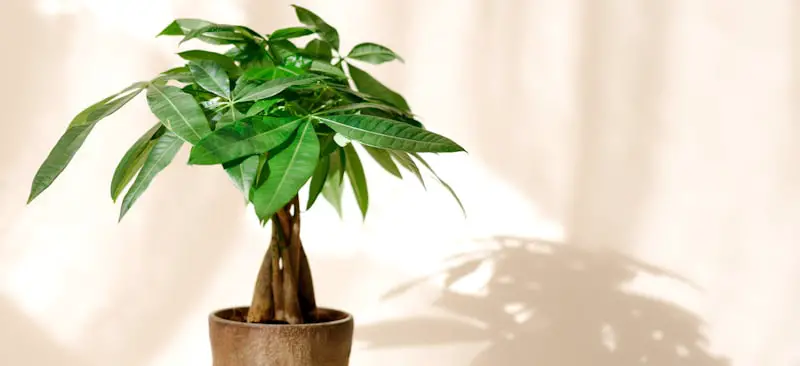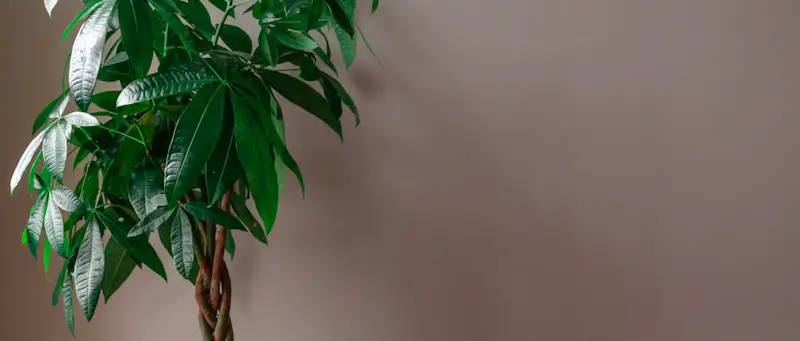Although money tree plants do not guarantee future fortune, they are well-liked. Only extremely hot temperatures are suitable for growing these deciduous evergreens, which are native to the wetlands of South and Central America. Learning how to multiply these Pachira plants is one approach to growing more money trees.
Cutting is the most typical way of money tree propagation. Cuttings from money trees can be germinated in water before being planted straight in the ground. While liquid propagation is a wonderful way to observe your tree’s roots develop, soil propagation is typically more effective.
A feng shui notion that the tree is lucky and folklore that growing the plant provides significant prosperity are the sources of the name “money tree,” which is appealing. The flexible stems of the young trees are frequently braided to seal in the good fortune.

Propagate Money Tree
Many fans of money trees wish they could have so many in their houses. However, buying numerous fully established Money Trees is not always cost-effective. Not to worry, you do not need to be an expert gardener to cultivate your Money Trees, which can be a fun and economical way to begin a Pachira Aquatica collection.
Swamps in South and Central America are home to money trees. They can grow up to sixty feet in height in the wild, far higher than the knotted kind sold in stores; on average, they are about thirty feet tall. A Money Tree’s well-known braided stems are never a plant’s characteristic.
Instead, they are merely decorative effects that some claim lock in the prosperity the Money Tree brings. An indoor Money Tree bloom with braids is unusual to observe. However, Pachira Aquatica boasts some of the biggest flowers you can find on a tree in nature.
Money Tree blossoms have long petals that fold back to reveal a profusion of scarlet stamens. Most Pachira Aquatica lovers do not have the choice of growing their cherished plants from seeds because it is uncommon for a Money Tree to bloom indoors.
Do not let that discourage you. Without using seeds, there are two very easy ways to reproduce your Money Tree and all the splendor and luck it has to give. In both water and soil, a money tree can be multiplied. Cuttings must be used correctly for both methods.
Your propagation will go more smoothly if you correctly choose and manage your Money Plant trimming. Cuttings are the simplest method for propagating money trees. Cut the lowest part of a six-inch stem clipping with multiple leaf nodes of foliage, then immerse the cut end in the rooting enzyme.
Place the cut end of the workpiece into a small pot that has been prepared with a soilless medium till the lowest third of it is submerged. To keep it damp, moisten the soil and wrap the cutting under a plastic bag. Before the chopped roots can take hold and the small money tree can be moved into a bigger pot, it can take about six to eight weeks.
Propagating Money Tree
You can have endless baby money trees if you understand how to propagate them. You may now mail the famous trees to your family members as gifts instead of having to purchase them from nearby nurseries. Propagating money trees is similar to how seeds grow.
It is similar to how seeds grow when money trees are propagated from cuttings. Based on the moisture levels, the caliber of cuttings, and the care you give, it has a chance of success of between 80 and 90 percent. The maturity of the money tree will enhance the performance of the cuttings you receive, which increases the likelihood of root development.
From the money three, cut a stem with 2 to 3 nodes, at the very least. A fresh shoot develops at a node. It will produce new roots instead of new shoots once grown in the ground. Cutting stems too short could cause them to die. More starch is present in the nodes on the broader part of the stem, which gives the cuttings adequate support.
Cut the stems with precise pruning shears. Stems that have been clipped precisely avoid injuring the parent plant and reveal its inner branches to possible intruders like fungi. Add the rooting enzyme to the tips of your freshly cut money tree branches before planting them in a single container.
Auxins found in rooting hormones cause plants to start roots; it comes in powder and is simple to apply to the exposed stem area. Their environment and indoor circumstances will impact the cuttings’ survival. So, to assist them to flourish, you must replicate a moist environment, put the cuttings in a humid area and cover them with a transparent plastic bag.
You can transplant the cuttings into different pots once their roots have expanded sufficiently and produced fresh leaves. They will require more room to spread their roots and use the soil’s nutrients without competition.
Money Tree Cutting
Using a rooting media rather than water to provide a Pachira Aquatica cutting is the best root system and the chance of successful propagation. The absence of oxygen causes most cuttings to struggle when rooted in water, resulting in a poorer root system.
Take your softwood cutting as soon as new growth shows during the planting season, typically late spring to mid-summer. Take your cutting early in the day while it is coldest outside. Snip off a 6-inch part of a healthy branch with the recent development, leaving 2 to 3 leaf nodes, as that is where the new roots will sprout.
Use a disinfected pruning tool to prevent the spread of disease to the cut or parent plant. If you cannot plant your cutting right away, wrap it securely in a damp paper towel and store it in a plastic container until you can.

Where To Cut Money Tree To Propagate
When it regards cutting a money tree for propagation, you cannot and should not just cut any part of the tree. Look for healthy, lively areas of your Money Tree before chopping the plant. By saving healthy pieces, you can employ propagation to salvage a dying money tree; however, your cutting must not have any dry or mushy stems.
Your objective is to locate a sturdy, green portion of the stem about six inches long and has two to three leaf nodes near the cutting’s base. The locations along the stem where leaves are sprouting are known as leaf nodes and frequently resemble lumps or knots.
Those nodes will act as the origin of a fresh set of roots after the leaves are eliminated and propagation gets going. You are prepared to cut once you have selected your healthy plant portion. Cut about a centimeter below the nodes underneath the 6-inch length of stem; make an effort to cut at an angle of 45 degrees.
Cut about a centimeter below those nodes at the bottom of your six-inch length of the stem. Make an effort to cut at a 45-degree angle. Try getting a second cut of the money tree if it has extra healthy branches available to increase the likelihood of successful replication.
After you have the fresh cuttings, place the ends of the clean towel inside a plastic container and cover the bases of the cuttings inside the towel. Leave it moisturized while preparing for the next steps.
Final Thoughts
Money trees are healthy, hardy plants that can be multiplied to provide years of enjoyment. You may replicate your money tree in water or soil by following a few easy instructions, providing it with the ideal environment for growth. Keep in mind to guard your money tree against extremes of temperature, light, or humidity, and be patient and gentle with it as it grows.
Similar post:
- How to Propagate Fiddle Leaf Fig
- How To Propagate A String Of Hearts?
- How To Propagate Wandering Jew
Victoria is the owner and main author of hobby plants. She loves spending her free time in her garden planting and taking care of her plants. Victoria hopes you enjoy the content here!
![Best Soil For A Money Tree? [DIFFERENCES EXPLAINED] Best Soil For A Money Tree? [DIFFERENCES EXPLAINED]](https://www.hobbyplants.com/wp-content/uploads/2022/08/best-soil-for-money-tree-300x158.jpg)
![How Often Should You Water Pothos? [Complete Care Guide] How Often Should You Water Pothos? [Complete Care Guide]](https://www.hobbyplants.com/wp-content/uploads/2022/07/how-often-to-water-pothos-300x158.jpg)
![How Often Should You Water Ferns? [COMPLETE CARE GUIDE] How Often Should You Water Ferns? [COMPLETE CARE GUIDE]](https://www.hobbyplants.com/wp-content/uploads/2022/08/how-often-to-water-ferns-300x158.jpg)
![How To Propagate Wandering Jew? [COMPLETE BEGINNER'S GUIDE] How To Propagate Wandering Jew? [COMPLETE BEGINNER'S GUIDE]](https://www.hobbyplants.com/wp-content/uploads/2022/07/how-to-propagate-wandering-jew-300x158.jpg)
![How To Propagate Pothos? [COMPLETE BEGINNER'S GUIDE] How To Propagate Pothos? [COMPLETE BEGINNER'S GUIDE]](https://www.hobbyplants.com/wp-content/uploads/2022/07/how-to-propagate-pothos-300x158.jpg)
![How To Propagate Prayer Plant? [COMPLETE BEGINNER'S GUIDE] How To Propagate Prayer Plant? [COMPLETE BEGINNER'S GUIDE]](https://www.hobbyplants.com/wp-content/uploads/2022/07/how-to-propagate-prayer-plant-300x158.jpg)

![Polka Dot Plant Care? [Everything You Need To Know] Polka Dot Plant Care? [Everything You Need To Know]](https://www.hobbyplants.com/wp-content/uploads/2022/08/polka-dot-plant-care-300x158.jpg)
![How Often Do You Water A Snake Plant? [FIND OUT HERE] How Often Do You Water A Snake Plant? [FIND OUT HERE]](https://www.hobbyplants.com/wp-content/uploads/2022/07/how-often-do-you-water-a-snake-plant-1-300x158.jpg)
![How To Propagate A String Of Hearts? [BEGINNER'S GUIDE] How To Propagate A String Of Hearts? [BEGINNER'S GUIDE]](https://www.hobbyplants.com/wp-content/uploads/2022/07/how-to-propagate-string-of-hearts-300x158.jpg)
![How To Propagate Snake Plant? [BEGINNER'S GUIDE] How To Propagate Snake Plant? [BEGINNER'S GUIDE]](https://www.hobbyplants.com/wp-content/uploads/2022/08/how-to-propagate-snake-plant-300x158.jpg)
![How to Propagate Fiddle Leaf Fig [BEST METHODS] How to Propagate Fiddle Leaf Fig [BEST METHODS]](https://www.hobbyplants.com/wp-content/uploads/2022/06/how-to-propagate-fiddle-leaf-fig-300x158.jpg)